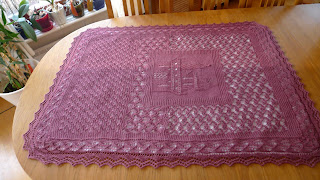A collegue of mine has just had her second child. A girl this time. She asked me if I could make her a baby quilt. I'm always happy for an excuse to make something, but I warned her. I was going to make it sweet and pink this time. As you might have guessed, pink and sweet is not her thing. So to tease her, I made a pink knitted lace, with a white quilted silk carpet below. Could it be sweeter?
A little worried about what she was going to say, I chose as a motive for the knitted lace a tableau from one of my favourite books as a child, "Mio my Mio" by Astrid Lindgren. This book has many dimensions, but the story I wanted the little girl to carry with her trough life, is to have the courage to stand up to people who want to control you.
 Mio is actually named Bosse, and lives in
Mio is actually named Bosse, and lives in  Mio finally experiences what it means to be loved, and he gets many friends. But he also discovers that there comes responsibility with being a prince. In the land Beyond, the evil Knight Kato rules with an iron fist. He captures disobedient children and turns them into birds who are doomed to circle his castle for all eternity.
Mio finally experiences what it means to be loved, and he gets many friends. But he also discovers that there comes responsibility with being a prince. In the land Beyond, the evil Knight Kato rules with an iron fist. He captures disobedient children and turns them into birds who are doomed to circle his castle for all eternity. Mio, which is a scared and shy little boy, realizes that he is the only one who can save these children. He finds the courage to ride out with his best friend Jumjum, to challenge the evil Knight Kato. Because of his kindness to people he meets along the way, he gets the help he needs to defeat the knight and free the children. The motive for this blanket is when Mio challenges Kato and wins.
Mio, which is a scared and shy little boy, realizes that he is the only one who can save these children. He finds the courage to ride out with his best friend Jumjum, to challenge the evil Knight Kato. Because of his kindness to people he meets along the way, he gets the help he needs to defeat the knight and free the children. The motive for this blanket is when Mio challenges Kato and wins. At the centre of this blanket, I have knitted a pattern called "The Ginger bread castle". I can not remember if this happens in the book, but I chose to put the knight's castle on fire. The flames are a pattern called "Bleeding harts", while the cliffs below the castle is a pattern called "Purl shell pattern". Around the castle birds are flying, which is a pattern called "Shower head". All these patterns you may find in Barbara G. Walker's book series "A Treasury of Knitting Patterns". The blanket is knitted in a beautiful silk and alpaca yarn from Du store alpaca, named Fin, in a deep pink colour (229).
At the centre of this blanket, I have knitted a pattern called "The Ginger bread castle". I can not remember if this happens in the book, but I chose to put the knight's castle on fire. The flames are a pattern called "Bleeding harts", while the cliffs below the castle is a pattern called "Purl shell pattern". Around the castle birds are flying, which is a pattern called "Shower head". All these patterns you may find in Barbara G. Walker's book series "A Treasury of Knitting Patterns". The blanket is knitted in a beautiful silk and alpaca yarn from Du store alpaca, named Fin, in a deep pink colour (229).
Many of us meet people who are trying to get us to do things we really do not want to do. It takes great courage to stand up to such pressure, to be who you are.
"Mio my Mio".




















